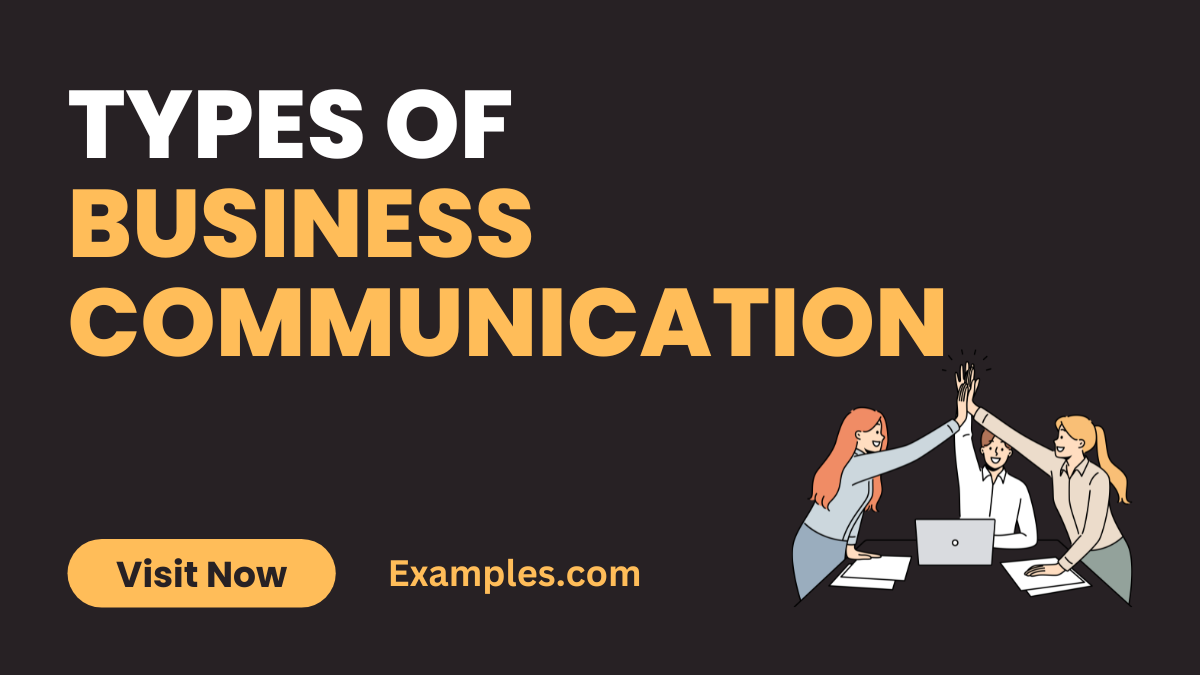Types of Business Communication – Examples, Types
In today’s dynamic corporate world, mastering various types of business communication is crucial. This comprehensive guide delves into diverse communication styles and methodologies, enriched with practical communication examples. From internal dialogues to external interactions, it covers every facet necessary for effective communication in the business sphere. Whether you’re a budding entrepreneur or a seasoned executive, this guide offers valuable insights to enhance your communicative prowess in the professional environment.
Download Types of Business Communication PDF
Types of Business Communication List

- Emails : A common issue is misinterpretation. Clear, concise language and re-reading before sending can prevent misunderstandings.
- Meetings : Ineffective meetings can waste time. Setting clear agendas and objectives can make meetings more productive.
- Reports (Effective Business Communication): Poorly structured reports lead to confusion. Structuring reports with clear headings and summaries can enhance understanding.
- Presentations (Business Communication Techniques): Anxiety can hinder delivery. Practice and preparation can improve confidence and clarity.
- Networking : Inexperience can make networking daunting. Learning networking strategies can boost confidence and effectiveness.
- Negotiations (Business Communication Skills): Miscommunication can derail negotiations. Active listening and clear articulation of points can lead to successful outcomes.
- Feedback Sessions : Negative feedback can demotivate. Constructive feedback, focused on improvement, can motivate and guide.
- Corporate Blogs (How to Improve Business Communication): Lack of engagement can render blogs ineffective. Engaging content tailored to the audience can increase impact.
- Social Media : Cultural misunderstandings can arise. Awareness of cultural nuances and targeted communication can mitigate this.
- Training Sessions (Business Communication Tools): Ineffective training can lead to skill gaps. Interactive and practical training methods can enhance learning and retention.
- Video Conferences (Business Communication in the Workplace): Technical issues can disrupt meetings. Ensuring a stable internet connection and familiarity with the platform can improve the experience.
- Internal Newsletters : Overload of information can lead to disinterest. Concise and relevant content can keep staff informed and engaged.
- Customer Service Communications : Misunderstandings can affect customer satisfaction. Empathetic listening and clear responses can enhance customer relations.
- Interdepartmental Memos : Lack of clarity can cause confusion. Simple, direct language and stating clear objectives can ensure better understanding.
- Crisis Communication (Business Communication Problems & Solutions): Poor handling of crises can damage reputation. Transparent, timely communication can build trust and mitigate issues.
- Branding Material : Inconsistent messaging can weaken brand identity. Unified and clear brand messages strengthen corporate identity.
- Public Relations Releases (Importance of Business Communication): Ambiguity can lead to public misinterpretation. Factual and precise information upholds company integrity and public trust.
- Employee Surveys (Advantages of Business Communication): Low response rates can skew results. Encouraging participation through anonymity and simplicity can yield more accurate feedback.
- Project Proposals: Vagueness can lead to rejection. Detailed and well-structured proposals can increase the likelihood of approval.
- Corporate Social Responsibility Reports (Business Communication Styles): Lack of transparency can raise doubts. Clear, honest reporting on CSR activities can enhance company image and stakeholder trust.
- Training Manuals : Complexity can hinder learning. User-friendly, straightforward manuals facilitate better understanding and skill development.
- Sales Pitches : Overcomplicated pitches can confuse potential clients. Focusing on key benefits and clear explanations can make pitches more effective.
- Organizational Charts : Outdated charts can mislead. Regular updates ensure accurate representation of company structure.
- Job Advertisements : Unclear job descriptions can attract unsuitable candidates. Specific and detailed job ads can attract the right talent.
- Onboarding Documents (Business Communication for Students): Overwhelming information can confuse new hires. Streamlined, essential information eases the onboarding process.
- Press Conferences : Poorly managed press conferences can lead to negative publicity. Well-prepared and coherent delivery can effectively convey the intended message.
- Investor Updates : Inconsistent updates can create investor uncertainty. Regular and clear updates can maintain investor confidence.
- Team Briefings : Lack of engagement can lead to misinformation. Interactive and focused briefings can improve team alignment and performance.
- Customer FAQs: Inadequate FAQs can leave customers confused. Comprehensive and easy-to-understand FAQs can enhance customer satisfaction and reduce support queries.
- Corporate Newsletters: Irrelevant content can lead to disengagement. Tailoring newsletters to audience interests can increase readership and engagement.
In conclusion, the realm of business communication is vast and multifaceted, encompassing a range of types and styles each with its own unique features and advantages. To navigate this complex landscape effectively, understanding and mastering different communication styles is essential.
This form encompasses emails, reports, and memos. It’s great for maintaining records and providing detailed instructions or information, but lacks the immediacy and personal touch of verbal communication. For insights into improving written communication in the business context, the Open Textbook Library offers a comprehensive guide.
Recognizing and adapting to different communication styles is key to effective leadership and team dynamics. Harvard’s Division of Continuing Education offers insights on assessing and adapting your communication style for maximum effectiveness, as outlined in their article on Workplace Communication Styles.



